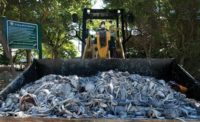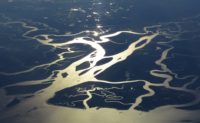A senior state legislator has proposed a $2.4-billion response to the toxic algal blooms that fouled estuaries and beaches on Florida’s Atlantic and Gulf coasts in July. The blooms prompted bitter complaints from coastal residents, repelled tourists and led Gov. Rick Scott (R) to declare a state of emergency and appeal in vain for federal emergency aid. On Aug. 9, Sen. Joe Negron (R), president-designate of Florida’s state senate, unveiled a plan to purchase land south of Lake Okeechobee for a 60,000-acre reservoir to store 120 billion gallons of polluted lake water, which currently is discharged to tide when the lake rises to a level that threatens the dike that encloses it.
Agricultural and residential runoff enters Lake Okeechobee via the Kissimmee Basin, carrying nutrients that, under certain conditions, feed a bloom of blue-green algae. The U.S. Army Corps of Engineers monitors the lake’s level and operates the controls to discharge lake water when necessary. Discharges go east to the estuary of the St. Lucie River and west to the Caloosahatchee estuary. Heavy rainfall this summer raised the lake’s level, forcing the Corps to discharge water containing the algal bloom, and the results made headlines throughout the country.
Negron proposed two possible sites for the reservoir. “Their geographic location makes them ideal to take advantage of existing canals and other conveyances,” he said. “The particular makeup of the property itself in terms of configuration will give us the maximum ability to store water and also to clean the water before it goes to Everglades National Park and out to Florida Bay.” He is proposing only one reservoir to be built on one of the proposed sites, and said, “There may be other places south of the lake that we should consider. I’m open to looking at other options.”
Negron said he has been meeting with scientists, community leaders, the agriculture community and other experts on the best way to reduce discharges from the lake. “All the evidence confirms what I’m here to say today: We must buy land south.” Major stakeholders tell ENR, however, that they were not consulted on his proposal. The Corps of Engineers, the South Florida Water Management District and sugar industry representatives say they learned of it only when he announced it. “Senator Negron did not speak with the cooperative,” says Barbara Miedema, vice president of the Sugar Cane Growers Cooperative of Florida. “We were unaware of what he was going to announce until we watched the press conference.”
The cane growers are a crucial stakeholder because almost all the land in Negron’s proposed sites is their property. “In an average year, our growers grow sugar cane on 72,000-75,000 acres, so obviously if 60,000 acres of sugar cane were taken out of production, it would have a negative impact,” Miedema says.
But environmental groups cheered the proposal. “We were really pleased to hear [Negron’s] announcement, because it showed bold leadership,” says Jonathan Ullman, spokesman for the Sierra Club. “It was about a real solution to the algae crisis.” He says the chances of success for Negron’s proposal are good, “considering that he is the Florida Senate president-designate. He’s in a very unique position to get this done.”
Negron estimates the total cost of land acquisition and construction at $2.4 billion, to be equally shared between the state and the federal government, as is done with the projects of the Comprehensive Everglades Restoration Plan. He proposes to fund the state’s share with about $100 million annually from a stamp tax reserved for land acquisition to protect the environment over the next 20 years under a 2014 voter-approved amendment to the state constitution.




Post a comment to this article
Report Abusive Comment